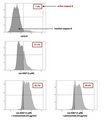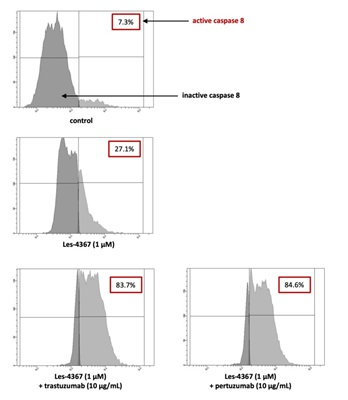Ships: 1-2 business days
- Prepare samples and controls
- Dilute 10X Apoptosis Wash Buffer 1:10 with diH20.
- Reconstitute FLICA with 50 μL DMSO.
- Dilute FLICA 1:5 by adding 200 μL PBS.
- Add diluted FLICA to each sample at 1:30 (e.g., add 10 μL to 290 μL of cultured cells).
- Incubate approximately 1 hour.
- Remove media and wash cells 3 times: add 1X Apoptosis Wash Buffer and spin cells.
- If desired, label with additional stains, such as Hoechst, Propidium Iodide, 7-AAD, or an antibody.
- If desired, fix cells.
- Analyze with a fluorescence microscope, fluorescence plate reader, or flow cytometer. FAM-FLICA excites at 492 nm and emits at 520 nm.
If working with adherent cells, please see the manual for additional protocols.
Kit 99: 25 Tests
FLICA Caspase-8 Reagent (FAM-LETD-FMK), 1 vial, #656
10X Apoptosis Wash Buffer, 15 mL, #635
Fixative, 6 mL, #636
Propidium Iodide, 1 mL, #638
Hoechst 33342, 1 mL, #639
Kit Manual
Kit 910: 100 Tests
FLICA Caspase-8 Reagent (FAM-LETD-FMK), 4 vials, #656
10X Apoptosis Wash Buffer, 60 mL, #634
Fixative, 6 mL, #636
Propidium Iodide, 1 mL, #638
Hoechst 33342, 1 mL, #639
Kit Manual
Product Specific References
| PMID | Publication |
| 39366751 | Xia, Y, et al. 2024. PARP inhibitors enhance antitumor immune responses by triggering pyroptosis via TNF-caspase 8-GSDMD/E axis in ovarian cancer. Journal for Immunotherapy of Cancer, . |
| 39199694 | Finiuk, N., et al. 2024. The Proapoptotic Action of Pyrrolidinedione-Thiazolidinone Hybrids towards Human Breast Carcinoma Cells Does Not Depend on Their Genotype. Cancers, . |
| 38791473 | Krętowski, R., et al. 2024. The Synergistic Effect of Reduced Graphene Oxide and Proteasome Inhibitor in the Induction of Apoptosis through Oxidative Stress in Breast Cancer Cell Lines. International journal of molecular sciences. |
| 38788367 | Radomska, D., et al. 2024. Evaluation of anticancer activity of novel platinum(II) bis(thiosemicarbazone) complex against breast cancer. Bioorganic chemistry, 107486. |
| 37998361 | Spurlock, M., et al. 2023. The Inflammasome-Dependent Dysfunction and Death of Retinal Ganglion Cells after Repetitive Intraocular Pressure Spikes. Cells. |
| 36604548 | Chao, Y.Y., et al. 2023. Human TH17 cells engage gasdermin E pores to release IL-1α on NLRP3 inflammasome activation. Nature immunology, 295-308. |
| 36768675 | Rok, J., et al. 2023. The Assessment of the Phototoxic Action of Chlortetracycline and Doxycycline as a Potential Treatment of Melanotic Melanoma—Biochemical and Molecular Studies on COLO 829 and G-361 Cell Lines. International Journal of Molecular Sciences, 2353. |
| 37001390 | Ivasechko, I., et al. 2023. Molecular design, synthesis and anticancer activity of new thiopyrano[2,3-d]thiazoles based on 5-hydroxy-1,4-naphthoquinone (juglone). European journal of medicinal chemistry, 115304. |
| 36902392 | Peng, Z., et al. 2023. Enhanced Apoptosis and Loss of Cell Viability in Melanoma Cells by Combined Inhibition of ERK and Mcl-1 Is Related to Loss of Mitochondrial Membrane Potential, Caspase Activation and Upregulation of Proapoptotic Bcl-2 Proteins. International journal of molecular sciences. |
| 37047765 | Gornowicz, A., et al. 2023. Multi-Targeting Anticancer Activity of a New 4-Thiazolidinone Derivative with Anti-HER2 Antibodies in Human AGS Gastric Cancer Cells. International journal of molecular sciences. |
| 37763082 | Mańka, S., et al. 2023. Cytotoxic Activity of Melatonin Alone and in Combination with Doxorubicin and/or Dexamethasone on Diffuse Large B-Cell Lymphoma Cells in In Vitro Conditions. Journal of Personalized Medicine, 1314. |
| 35055021 | Rok, J., et al. 2022. The Anticancer Potential of Doxycycline and Minocycline-A Comparative Study on Amelanotic Melanoma Cell Lines. International journal of molecular sciences. |
| 35270004 | González-Sarrías, A., et al. 2022. Milk-Derived Exosomes as Nanocarriers to Deliver Curcumin and Resveratrol in Breast Tissue and Enhance Their Anticancer Activity. International journal of molecular sciences, . |
| 35352212 | Hassona, S.M., et al. 2022. Palladium(II) Schiff base complex arrests cell cycle at early stages, induces apoptosis, and reduces Ehrlich solid tumor burden: a new candidate for tumor therapy. Investigational new drugs. |
| 36296570 | Janowska, S., et al. 2022. Synthesis and Anticancer Activity of 1,3,4-Thiadiazoles with 3-Methoxyphenyl Substituent. Molecules. |
| 35467089 | Kubiak, A.B., et al. 2022. The influence of venetoclax, used alone or in combination with cladribine (2-CdA), on CLL cells apoptosis in vitro: Preliminary results. Advances in clinical and experimental medicine : official organ Wroclaw Medical University. |
| 33500339 | Lima, T.S., et al. 2021. Toxoplasma gondii Extends the Life Span of Infected Human Neutrophils by Inducing Cytosolic PCNA and Blocking Activation of Apoptotic Caspases. mBio, 125134. |




